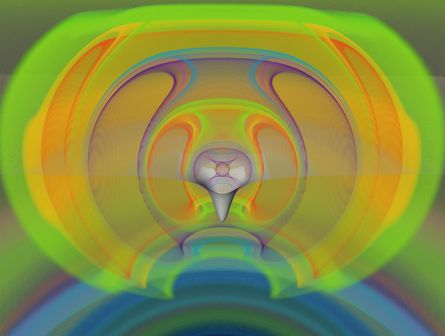When will a neutron star collapse to a black hole?

Simulation of gravitational waves from a collapsing neutron star. Luciano Rezzolla
Neutron stars are the most extreme and fascinating objects known to exist in our universe: Such a star has a mass that is up to twice that of the sun but a radius of only a dozen kilometres: hence it has an enormous density, thousands of billions of times that of the densest element on Earth.
An important property of neutron stars, distinguishing them from normal stars, is that their mass cannot grow without bound. Indeed, if a nonrotating star increases its mass, also its density will increase. Normally this will lead to a new equilibrium and the star can live stably in this state for thousands of years.
This process, however, cannot repeat indefinitely and the accreting star will reach a mass above which no physical pressure will prevent it from collapsing to a black hole. The critical mass when this happens is called the “maximum mass” and represents an upper limit to the mass that a nonrotating neutron star can be.
However, once the maximum mass is reached, the star also has an alternative to the collapse: it can rotate. A rotating star, in fact, can support a mass larger than if it was nonrotating, simply because the additional centrifugal force can help balance the gravitational force.
Also in this case, however, the star cannot be arbitrarily massive because an increase in mass must be accompanied by an increase in rotation and there is a limit to how fast a star can rotate before breaking apart. Hence, for any neutron star there is an absolute maximum mass and is given by the largest mass of the fastest-spinning model.
Determining this value from first principles is difficult because it depends on the equation of state of the matter composing the star and this is still essentially unknown. Because of this, the determination of the maximum rotating mass of a neutron star has been an unsolved problem for decades. This has changed with a recent work published on Monthly Notices of the Royal Astronomical Society, where it has been found that it is indeed possible to predict the maximum mass a rapidly rotating neutron star can attain by simply considering what is maximum mass of corresponding the nonrotating configuration.
“It is quite remarkable that a system as complex as a rotating neutron star can be described by such a simple relation”, declares Prof. Luciano Rezzolla, one of the authors of the publication and Chair of Theoretical Astrophysics at the Goethe University in Frankfurt. “Surprisingly, we now know that even the fastest rotation can at most increase the maximum mass of 20% at most”, remarks Rezzolla.
Although a very large number of stellar models have been computed to obtain this result, what was essential in this discovery was to look at this data in proper way. More specifically, it was necessary to realise that if represented with a proper normalisation, the data behaves in a universal manner, that is, in a way that is essentially independent of the equation of state.
“This result has always been in front of our eyes, but we needed to look at it from the right perspective to actually see it”, says Cosima Breu, a Master student at the University of Frankfurt, who has performed the analysis of the data during her Bachelor thesis.
The universal behaviour found for the maximum mass is part of a larger class of universal relations found recently for neutron stars. Within this context, Breu and Rezzolla have also proposed an improved way to express the moment of inertia of these rotating stars in terms of their compactness. Once observations of the moment of inertia will be possible through the measurement of binary pulsars, the new method will allow us to measure the stellar radius with a precision of 10% or less.
This simple but powerful result opens the prospects for more universal relations to be found in rotating stars. “We hope to find more equally exciting results when studying the largely unexplored grounds of differentially rotating neutron stars”, concludes Rezzolla.
Publication: Cosima Breu, Luciano Rezzolla: Maximum mass, moment of inertia and compactness of relativistic, in: Monthly Notices of the Royal Astronomical Society http://mnras.oxfordjournals.org/content/early/2016/03/14/mnras.stw575
Informationen: Prof. Luciano Rezzolla, Institut für Theoretische Physik, Campus Riedberg, Tel,: (069) 798 47871, rezzolla@th.physik.uni-frankfurt.de.
http://tinygu.de/Neutronensterne Interview with Cosima Breu and Luciano Rezzolla on Goethe-Uni online.
http://mnras.oxfordjournals.org/content/early/2016/03/14/mnras.stw575 publication
Media Contact
All latest news from the category: Physics and Astronomy
This area deals with the fundamental laws and building blocks of nature and how they interact, the properties and the behavior of matter, and research into space and time and their structures.
innovations-report provides in-depth reports and articles on subjects such as astrophysics, laser technologies, nuclear, quantum, particle and solid-state physics, nanotechnologies, planetary research and findings (Mars, Venus) and developments related to the Hubble Telescope.
Newest articles

Silicon Carbide Innovation Alliance to drive industrial-scale semiconductor work
Known for its ability to withstand extreme environments and high voltages, silicon carbide (SiC) is a semiconducting material made up of silicon and carbon atoms arranged into crystals that is…

New SPECT/CT technique shows impressive biomarker identification
…offers increased access for prostate cancer patients. A novel SPECT/CT acquisition method can accurately detect radiopharmaceutical biodistribution in a convenient manner for prostate cancer patients, opening the door for more…

How 3D printers can give robots a soft touch
Soft skin coverings and touch sensors have emerged as a promising feature for robots that are both safer and more intuitive for human interaction, but they are expensive and difficult…





















